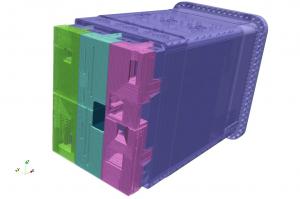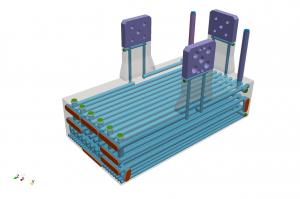Pushing manufacturing to the limit
At the end of 2019, a reduced-scale mockup produced by the Spanish firm IDONIAL was presented in an expert design review and the techniques were approved.
"This extra step of constructing a reduced-scale mockup was useful because it helped us develop new manufacturing procedures and to discard others," says Julio Guirao, Common Port plug Components Engineer. "Our mockup validated the combined use of several techniques —gun drilling machining, circular TIG (tungsten inert gas) welds, PAW (plasma arc-welding), ArcTIG (an innovative version of the tungsten inert gas for mechanized joint welding), and ESW (electroslag welding) overlays. We were able to test the structural integrity and thermal hydraulic performance resulting from each approach."
Demonstrating a number of special techniques on a reduced scale
Diagnostic first walls play an essential role for the systems that measure what is happening in the ITER Tokamak during a pulse. One of three main protective components of equatorial port plugs, diagnostic first walls provide thermal and nuclear shielding to both the diagnostic shielding modules and the diagnostic systems themselves. (The other two protective components are the port plug structures, part of the confinement barrier, and the diagnostic shielding modules, the frames which house diagnostics and provide extra shielding).
Diagnostic first walls must provide line of sight for the diagnostic systems through cutouts in the walls, but because each of the diagnostic systems operates differently, each of the 82 first walls requires different apertures. For example, some diagnostics shine a laser beam into the plasma. The beam needs to pass through a cutout and also have some freedom of movement to shine from different angles. The holes have to be big enough for the diagnostics—but to maximize protection, they can be no bigger than necessary.
Also challenging to manufacture are the connective tabs that will attach each diagnostic first wall to a diagnostic shielding module. To protect them from heat, cooling channels must be implemented in the tabs. "This has required the development of specific welding procedures to close the pockets around the apertures," says Guirao. "With standard TIG welding, we run the risk of having thermal distortions as we would need several passes and welds are quite close to each other. Instead, on the reduced-scale mockup we showed that plasma welding could weld the whole thickness in one pass, minimizing distortions. We are also testing newer processes based on arcTIG welding to bring more flexibility to the manufacturing. Once procedures are developed, we recommend them to the manufacturer."
Progressing to the manufacturing phase
Since the successful expert design review, the ITER Organization has completed a tender process and is now preparing a manufacturing contract for all 82 diagnostic first walls.
"Although we have already demonstrated that the advanced manufacturing techniques work in a reduced scale mockup, to minimize production risks we now need to test how these methods work together in a life-sized component," says Guirao. "To do this, IDONIAL is building a full-scale mockup that demonstrates a number of combinations—for example, that massive gun drilling works with rather close welding."
The team expects to finish this full-scale mockup by the first quarter of 2021. "This is around the time we intend to start working with the supplier on the final manufacturing design," says Guirao. "All the documentation and knowledge generated by this mockup will be transferred to the supplier. In the end, the supplier decides how it intends to manufacture the diagnostic first walls—but the outcome of the mockup will provide very good guidance in anticipating risks." The final stage is the manufacturing readiness review, during which the ITER Organization makes its final assessment before giving its green light.



